Compare Core One vs Halot One Plus
Comparison between the best 3D printers
Choose the best 3D printer at the best price. The cheapest 3D printers are here.
Buy a 3D printer here with 3D Fila.
 |
 |
|
| Model | Core One |
Halot One Plus[BUY Halot One Plus] |
| Printing Material | Filament | Resin |
| Buy Filament for Prusa Core One | Buy Resin forCreality 3D Halot One Plus | |
| Estimated price | $1200,00 | $399,00 |
| Manufacturer | Prusa | Creality 3D |
| Release Year | 2025 | 2022 |
| Print Volume [mm] | 250x220x270 | 102x172x160 |
| Printer Size [mm] | 385x340x620 | 236x245x416 |
| Weight [kg] | 14 | 6,8 |
| Power Loss Recovery | YES | NO |
| Maximum Resolution [mm] | 0,01 | |
| Processor | xBuddy 32 bit | |
| Display | Touchscreen 3,5'' | |
| Power Supply | 240 W | |
| Connectivity | SD | USB / Wi-Fi |
| Operating systems | Windows, Linux e Macbook | |
| Date of registration in the system | 2024-11-27 | 2022-10-11 |
| Release date | 2025 | 2022 |
| Extra features | The Prusa Core One is a CoreXY 3D printer featuring a robust steel frame, a 3.5" touchscreen, and a heated chamber for technical filaments. It offers 360° cooling for improved print quality and supports upgrades from the MK4S model. With a compact design, a print volume of 270x250x220 mm, and compatibility with the MMU3 for multi-color printing, it stands out for its ease of maintenance, precision, and speeds up to 260% faster than the MK3S+. | Crealitys Halot-One Plus printer stands out for its 4K+ resolution that delivers sharp details and consistent surfaces. It features a fast and responsive 5-inch LCD interface, as well as easy-to-use Halot Box software. It offers Wi-Fi connectivity and remote print monitoring, as well as an integrated air filtration unit, a rare feature in this price range. The Halot-One Plus is designed for the prosumer market, combining high quality with advanced features such as Wi-Fi and air filtration. During testing, it stood out for implementing these features at an affordable cost, while maintaining functionality. It features an attractive design with a UV-resistant blue cover and a robust dual rail system for the Z-axis, ensuring smooth and consistent movements. The large LCD and high resolution of the LCD mask (4320 x 2560) are other strong points, allowing for fine details and textures in prints. |
| Support for multiple colors and materials (AMS and CFS) | YES | NO |
Notes * |
||
| Cost-benefit | 7 / 10 | 8 / 10 |
| Hardware | 6 / 10 | 1.4 / 10 |
| Tela | . | . |
| Print volume | 3 / 10 | 3 / 10 |
| Performance | 4 / 10 | 9 / 10 |
| [BUY Halot One Plus] |
Conclusion |
| In comparing the Core One and Halot One Plus 3D printers, it becomes evident that both cater to differing needs and priorities in the 3D printing landscape. The Core One, priced higher and released more recently, offers a larger print volume, advanced features like power loss recovery, and exceptional precision with its robust design and enhanced cooling. It is ideal for users seeking high-performance and versatility, particularly in technical filaments and multi-color printing, with a solid build and upgrade potential. Conversely, the Halot One Plus presents an impressive cost-to-feature ratio with its exceptional resolution and a suite of conveniences such as Wi-Fi connectivity and air filtration, making it well-suited for budget-conscious prosumers. Although it has a smaller print volume and lacks power loss recovery, its ease of use and sharp detail printing capabilities make it attractive for hobbyists and intermediate users. Ultimately, the decision hinges on the user's specific needs: those prioritizing print quality and advanced features may lean toward the Core One, while those valuing affordability and user-friendly features might find the Halot One Plus to be the better choice. |

